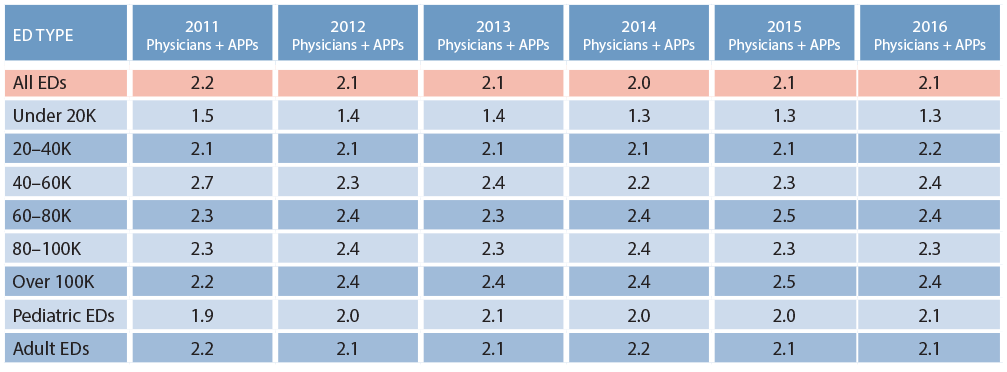
The management of patients in the emergency department requires skilled staff members working as a team to navigate the complex flow with high quality and patient safety. The growth in ED volumes that is continuing in America (and around the globe) requires constant update on the most effective staffing mix to accomplish operational goals.
Explore This Issue
ACEP Now: Vol 36 – No 09 – September 2017The Emergency Department Benchmarking Alliance (EDBA) has developed the definitions and descriptors of ED staffing and markers of performance. The definitions are completed and published and are being used in the annual EDBA survey.1 The definitions developed by the EDBA consider four classes of ED staff: physicians, advanced practice providers (APPs), nurses (not differentiating the various levels of staff nurses), and the group composed of personnel who function in technical and clerical roles.
The latest EDBA survey compiled data from more than 1,500 emergency departments that saw more than 60 million patients in calendar year 2016. The EDBA collects data on daily staffing to provide performance comparisons. A trend that is reportable is the increasing mix of APPs providing service in emergency departments that see more than 20,000 patients per year.
As the EDBA began its work in 1994, it was necessary to develop a formula that allowed comparison of staffing ratios where APPs were working in collaboration with emergency physicians. At that time, the shared role of ED patient management by physicians and APPs did not allow the same level of productivity of APPs as physicians. Emergency physicians at the time managed all patients in the emergency department independently, while APPs needed physician oversight of all work and typically were limited to seeing a low-acuity mix of patients. The EDBA has consistently assigned APPs a factor of 0.5 the number of physician hours to calculate the overall “professional productivity” (physicians plus APPs) in an emergency department. The EDBA calculation of the professional productivity for an emergency department that sees an average of 100 patients a day using 40 scheduled physician hours and 20 scheduled APP hours would result in a figure of 2.0 patients seen per hour. That is 100 patients divided by (40 physician hours + [20 APP hours multiplied by a factor of 0.5]), or 100 divided by (40 + 10), equals 2.0 patients per hour.
The six-year trend results of professional productivity from the EDBA data surveys are shown in Table 1. Across all the ED cohorts, productivity appears to be flat. Emergency physician staffing produces an average of 2.55 patients seen per hour. When attending physician coverage was supplemented by APPs, the professional productivity averaged 2.1 patients seen per hour.
Why the lack of improvement? The application of information technologies appears to have stalled the improvement in professional productivity, and the overall ability to see patients has been stable over the last six years. The technology must be simplified to place medical orders in the hospital systems, provide past medical records, and assist in documentation on patient care to improve the work capabilities of emergency physicians.
However, the mix is changing. Very few emergency departments that see less than 20,000 annual volume have APPs in their staffing mix. But above that number, most emergency departments now have APPs as a growing percentage of the professional hours. Table 2 shows that over the last seven years, the professional mix has increasingly featured work hours by APPs.
Emergency departments that use APPs for staffing now comprise 62 percent of all EDBA emergency departments. More important, in 2010, the APPs worked about 53 percent of the physician staffing hours. That means an emergency department that had an average of 60 emergency physician hours a day also had about 32 APP hours. In 2016, the APP hours comprised 64 percent of the emergency physician hours. That means that today, the same emergency department would now have 38 APP hours accompanying the 60 physician hours.
The most effective patient flow appears to increasingly favor the team use of emergency physicians and APPs to manage ED patients in emergency departments that see more than 20,000 patients per year. The EDBA data have followed the trend toward increasing use of APPs in the emergency department.
Reference
- Wiler JL, Welch S, Pines J, et al. Emergency department performance measures update: proceedings of the 2014 Emergency Department Benchmarking Alliance consensus summit. Acad Emerg Med. 2015;22(5):542-553.
Pages: 1 2 | Multi-Page








No Responses to “More Advanced Practice Providers Working in Emergency Departments”